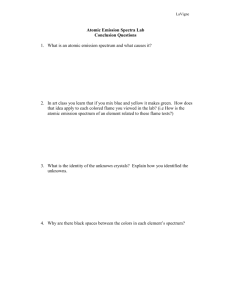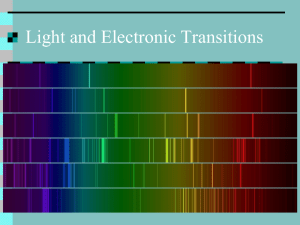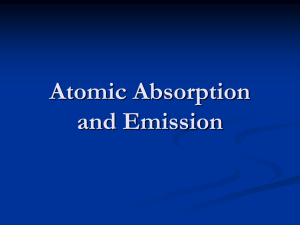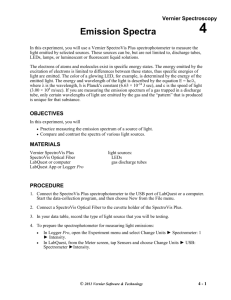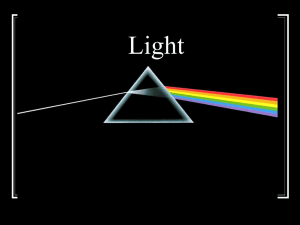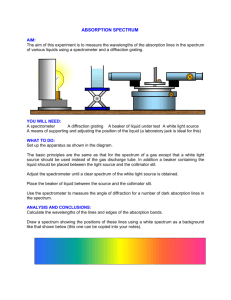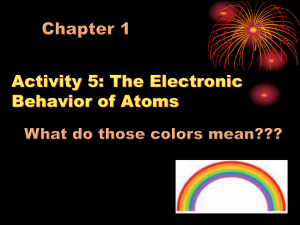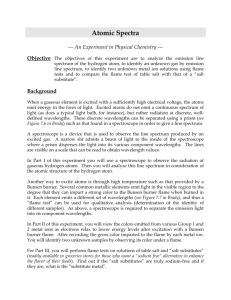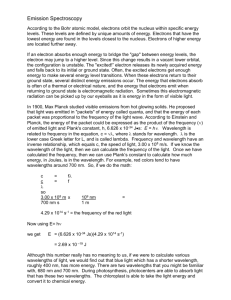Atomic Spectra and Atomic Structure
advertisement
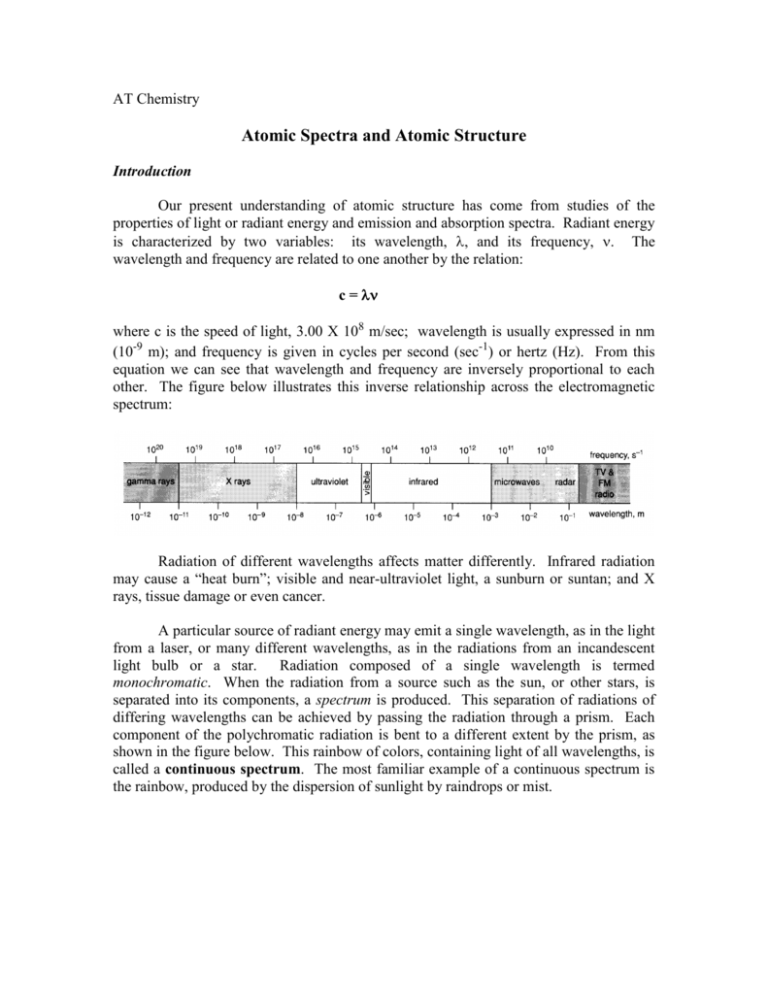
AT Chemistry Atomic Spectra and Atomic Structure Introduction Our present understanding of atomic structure has come from studies of the properties of light or radiant energy and emission and absorption spectra. Radiant energy is characterized by two variables: its wavelength, , and its frequency, . The wavelength and frequency are related to one another by the relation: c = where c is the speed of light, 3.00 X 108 m/sec; wavelength is usually expressed in nm (10-9 m); and frequency is given in cycles per second (sec-1) or hertz (Hz). From this equation we can see that wavelength and frequency are inversely proportional to each other. The figure below illustrates this inverse relationship across the electromagnetic spectrum: Radiation of different wavelengths affects matter differently. Infrared radiation may cause a “heat burn”; visible and near-ultraviolet light, a sunburn or suntan; and X rays, tissue damage or even cancer. A particular source of radiant energy may emit a single wavelength, as in the light from a laser, or many different wavelengths, as in the radiations from an incandescent light bulb or a star. Radiation composed of a single wavelength is termed monochromatic. When the radiation from a source such as the sun, or other stars, is separated into its components, a spectrum is produced. This separation of radiations of differing wavelengths can be achieved by passing the radiation through a prism. Each component of the polychromatic radiation is bent to a different extent by the prism, as shown in the figure below. This rainbow of colors, containing light of all wavelengths, is called a continuous spectrum. The most familiar example of a continuous spectrum is the rainbow, produced by the dispersion of sunlight by raindrops or mist. It was found that by placing a narrow slit between the source of radiation and the prism, the quality of the spectrum was improved and the monochromatic components were more sharply resolved. An instrument used for studying line spectra is called a spectroscope. A spectroscope contains the following: a slit for admitting a narrow, collimated beam of light; a prism for dispersing the light into its components; an eyepiece for viewing the spectrum; and an illuminated scale against which the spectrum may be viewed. Most substances will emit light energy if heated to a high enough temperature. For example, a fireplace poker will glow red if left in the fireplace flame for several minutes. Similarly, neon gas will emit bright red light when excited with sufficient high electrical voltage. When energy is absorbed by a substance, electrons within the atoms of the substance may be excited to positions of higher potential energy, farther from the nucleus. When these electrons return to their normal, or ground-state, position, energy will be emitted. Usually, some of the energy emitted occurs in the visible region of the electromagnetic spectrum, whose wavelength range is about 400-700 nm. Excited atoms do not emit a continuous spectrum, but rather emit radiation at only certain discrete, well defined, fixed wavelengths. For example, if you have ever spilled table salt (NaCl) into a flame, you have seen the characteristic yellow emission of excited sodium atoms. If the light emitted by the atoms of a particular element is viewed in a spectroscope, only certain bright-colored lines are seen in the spectrum. The figure 2 below illustrates the emission spectrum of hydrogen and is called a bright-line spectrum. The observation that a given excited atom emits radiation at only certain fixed wavelengths indicates that the atom can undergo energy changes only of certain fixed, definite amounts. An atom does not emit continuous radiation but rather emits energy corresponding to definite regular changes in the energies of its component electrons. The experimental demonstration of bright-line atomic emission spectra implied a regular, fixed electronic microstructure for the atom and led to the Bohr model for the hydrogen atom. This experiment consists of four parts. In part I you will calibrate your spectroscope; in part II you will observe emission spectra of hydrogen and calculate the electronic transition for each of the hydrogen lines, and mathematically and graphically verify the Rydberg constant; in Part III you will observe line spectra from flame tests; and in Part IV you will observe the absorption spectra of several transition metal ions. Part I. Emission Spectra In this part of the experiment, you will use a Vernier Spectrometer (V-SPEC) to measure the light emitted by selected sources. These sources can be, but are not limited to, discharge tubes, LEDs, lamps, or luminescent or fluorescent liquid solutions. The electrons of atoms and molecules exist in specific energy states. The energy emitted by the excitation of electrons is limited to differences between these states, thus specific energies of light are emitted. The color of a glowing LED, for example, is determined by the energy of the emitted light. The energy and wavelength of the light is described by the equation E = hc/λ, where λ is the wavelength, h is Planck's constant (6.63 × 10-34 J sec), and c is the speed of light (3.00 × 108 m/sec). If you are measuring the emission spectrum of a gas trapped in a discharge tube, only certain wavelengths of light are emitted by the gas and the “pattern” that is produced is unique for that substance. 3 Objectives In this experiment, you will Practice measuring the emission spectrum of a source of light. Compare and contrast the spectra of various light sources. Materials Vernier Spectrometer, w/o light source/ light sources: cuvette holder attachment LEDs computer discharge tubes (optional: fiber optic cable) lamp or flashlight Procedure 1. Use a USB cable to connect a Vernier Spectrometer to your computer. Make sure that the light source/cuvette holder has been detached from the spectrometer. (Optional) Connect a fiber optic cable to the threaded detector housing of the spectrometer. 2. Start the Logger Pro 3.4.6 program on your computer. 3. In your data table, record the type of light source that you will be testing. 4. Prepare the spectrometer to measure light emission. a. Open the Experiment menu and select Connect Interface → Spectrometer → Scan for Spectrometers. b. Open the Experiment menu and select Change Units → Spectrometer: 1 → Intensity. 5. Measure the emission spectrum of a light source. a. If you are not using a fiber optic cable, place the light source near (within a few cm) the detector opening on the spectrometer. The detector opening is a round, stainless steel piece that sits in a recessed area of the spectrometer. b. If you are using a fiber optic cable, aim the tip of the cable at the light source. c. Click . An emission spectrum will be graphed. You may have to adjust the position of the light source to get a suitable graph to appear. d. If necessary, move the light source toward or away from the detector so that the peak emission is less than ~1.5. When you achieve a satisfactory graph, click . Write down your observations of the emission spectrum in your data table. 6. To store the data, select Store Latest Run from the Experiment menu. 7. Repeat Step 5 with another light source, as directed by your instructor. 8. (Optional) Save and/or print a copy of your test results. Select Save As… from the File menu and save your experiment file. 9. Select Exit from the File menu to close down Logger Pro 3.4.6. 4 Data Table Trial Light Source Peaks or Unique Features Data Analysis 1. Describe, in detail, the emission spectrum of each light source. Emphasize the features of each spectrum that distinguishes it from the other light sources that you tested. 2. Identify the wavelengths of every peak in the graph of each light source. 3. Speculate about how the emission spectrum below might have been produced. Part III Emission Spectra for Some Metal Salts There is a short list of elements that, when their electrons are given some extra quanta of energy, the energy can be “seen” by the naked human eye. A common, visually interesting, activity in the chemistry lab is to demonstrate this phenomenon by placing one of these elements in a lab burner flame. A bright color will flash momentarily, signaling the energy exchange happening in the energy levels of the element. This activity, for one fairly obvious reason, is known as a flame test. It can be pulled off in many ways, from drizzling a few crystals of a salt onto a flame to evaporating a drop or two of salt solution over a flame. Thus, when you heat a drop of sodium chloride solution in a lab burner flame, for example, energy is added to the electrons of the sodium atom. This added energy is emitted when the excited electrons in the sodium atoms give off light and fall back to lower shells. The light emitted possesses wavelengths and colors, depending on the amount of energy the atoms absorbed. You’d expect that each excited sodium atom would emit one type of light. But it doesn’t quite work that way because there are billions and billions of atoms being excited and they produce billions of excitations and emissions. And not all of the atoms receive the same amount of energy, thus the excited electrons will travel to different energy levels. This means that the color produced by the heated NaCl solution is actually a series of discrete emission lines. Each emission describes one quantum path that an electron can take after it absorbs energy from the flame. Each element has a unique set of emission lines because each element’s electrons have a unique quantized distribution around the nucleus. The energy and wavelength of the light is described by the equation E = hc/λ, where λ is the wavelength, h is Planck's constant (6.63 × 10-34 J sec), and c is the speed of light (3.00 × 108 m/sec). If you capture the image of light emitted by an element heated by a flame, the color your eyes see can be broken down into a set of emission lines, and the emission lines are mathematically described by the equation shown above. 5 In this part of the experiment, you will use a spectrometer to measure the light emission produced by the salts of several elements as they are heated in a lab burner flame. You will use this information to draw comparisons between the various substances that you test. Objectives In this experiment, you will • • Measure the emission spectrum of various salt solutions. Characterize the emission spectra of produced by various elements. Materials Vernier Spectrometer, w/o light source/cuvette holder attachment or Vernier SpectroVis dropper bottles of salt solutions, which may include: LiCl, NaCl, KCl, SrCl2, CuCl2, BaCl2, CaCl2 computer platinum or nichrome wire flame loop Logger Pro 3 software distilled water fiber optic accessory dropper bottle of 1 M HCl solution lab burner Procedure 1. Use a USB cable to connect a spectrometer to your computer. Connect a fiber optic cable to the spectrometer. 2. Start Logger Pro 3 (version 3.6 or newer) on your computer. 3. In your data table, record the substances that you will be testing. 4. Prepare the spectrometer to measure light emission. a. Open the Experiment menu and select Change Units ► Spectrometer: 1 ► Intensity. b. Open the Experiment menu again and select Set Up Sensors ► Spectrometer:1. c. Change the Sample Time to 90 ms. Change the Samples to Average to 1. d. Click the red box in the upper right hand corner to close the dialog box. 5. Ignite the lab burner and adjust the flame so that it is mostly a blue color. The flame need not be vigorous. 6. Clean the flame loop by placing one drop of 1 M HCl on the loop itself. Hold the loop in the burner flame for about ten seconds. Repeat this process twice. 7. Measure the emission spectrum of a salt solution. Note: This step is easier to do with two people. One person should hold the fiber optic cable and a second person should work with the flame loop. a. Click > collect. 6 b. Hold the fiber optic cable with your fingers very nearly at the tip of the cable. Aim the tip of the cable toward the flame, and no close than 5-6 cm from the flame. If your fingertips are warm, the cable is probably too close to the flame. c. Select a dropper bottle of salt solution and place one drop of solution on the flame loop. d. Hold the loop in the burner flame. e. If the graph does not show a series of peaks, take the loop out of the flame and carefully cool it with a few drops of distilled water. Place another drop of the salt solution on the loop and place the loop back in the flame. f. When you achieve a satisfactory graph, click stop. Write down your observations of the emission spectrum in your data table. 8. To store the data, select Store Latest Run from the Experiment menu. 9. Repeat Steps 6 – 8 with the remaining salt solutions. 10. (Optional) Save and/or print a copy of your test results. Data Table – Flame Test Observations 7 Summary Salt Metal Color Flame Wavelengths of Emission Lines 8 Data Table – Energy Calculations salt Wavelength of emission line (m) Frequency (1/sec) Energy (J) Calculation Guide a. To convert wavelength, 1 nm = 1 × 10–9 m b. To calculate the frequency, use the equation: c = λν. c is the speed of light (3 × 108 m/s ),λ is the wavelength in meters, and ν is frequency. c. To calculate the energy of an emission line, use the equation: E = hν. The value of h, the , Planck constant, is 6.63 × 10-34 J sec. Data Analysis 1. Describe, in detail, the emission spectrum of each salt. Emphasize the features of each spectrum that distinguishes it from the other salts that you tested. 2. Identify the wavelengths of every peak in the graph of each salt. 3. Choose at least one emission line from each salt and calculate its energy. If possible, use a wide range of wavelengths. Compare the energies of the different emission lines. Which part of the visible light range possesses the greatest energy? Part IV. Absorption Spectra The absorption spectrum of an element is the “mirror image” of its emission spectrum. The principle is the same. If we took a solution of copper ions, for example, and passed white light through this solution with a spectroscope on the opposite side of the solution, we would observe a continuous spectrum interrupted by several dark lines. These dark lines represent the characteristic wavelengths of light absorbed by the copper ions (i.e. those that have the exact amount of energy to excite the electrons). These are the same wavelengths that are released when the excited electrons fall back to ground state levels producing an emission spectrum. Since copper ions appear green they reflect the green wavelengths of visible light while absorbing the complimentary color – red. We would thus expect to see prominent dark lines in the red portion of the absorption spectrum of copper ions. 9 The absorption spectra of six different salt solutions will be demonstrated. Record your observation in Data Sheet 4. Data Sheet 4 Fill in the color wheel below: Name of solution color colors absorbed by solution (dark lines) colors passing through solution ammonium dichromate __________ _______________ _______________ copper(II)chloride __________ _______________ _______________ iron(II)chloride __________ _______________ _______________ potassium permanganate __________ _______________ _______________ praseodymium chloride __________ _______________ _______________ erbium chloride __________ _______________ _______________ 10 Questions 1. Why does the flame test for a sodium ion result in a yellow flame, even though green and orange lines appear in the sodium ion emission spectrum? Explain. 2. If you could observe an absorption spectrum of hydrogen, what would it look like? Explain. 3. Metal ion solutions also contain anions such as chloride ion. When you observe the emitted light of metal ion solutions, how do you know the resulting spectra come from the cation, such as sodium ion, and not the anion, such as chloride ion? Describe an experiment you could perform to verify your answer. 4. Sodium ion, a common contaminant of potassium salts, often interferes with potassium ion flame tests. To get around this problem, we view the flame through a piece of cobalt blue glass to mask the color of the sodium ion flame. Briefly explain why the blue glass blocks the yellow light of the sodium ion but still allows the violet light of the potassium ion flame to pass through. This lab was taken from three sources: Hall, James F., Experimental Chemistry, 2nd edition, D.C. Heath & Co., 1989. Metz, Patricia A., “Determining Atomic Emission by Spectroscopy”, 1995, Chemical Education Resources. Absorption Spectroscopy kit by Flinn Scientific 11
